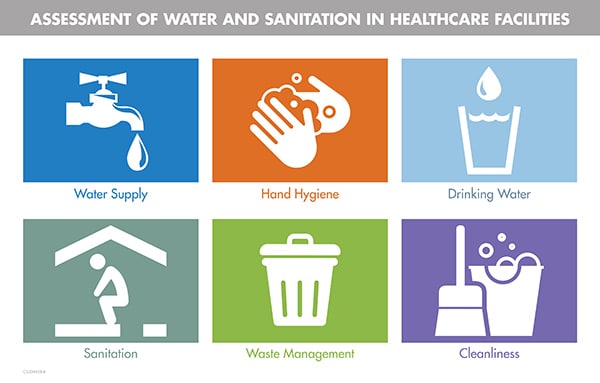Data Collection Tools and Communication
WHO and UNICEF have identified eight practical steps countries can take to achieve universal WASH coverage and access to quality care in healthcare facilities. To support the foundational first step of conducting situational analysis and assessment, CDC developed a suite of tools to evaluate WASH in primary healthcare facilities.
Situational Analysis and Assessment of WASH in Primary Healthcare Facilities
The CDC tool for evaluating access to WASH infrastructure and services in primary healthcare facilities consists of an interview with the healthcare facility director and a walk-through of the facility.
The information gathered from the assessment helps health officials understand the current WASH needs at each primary healthcare facility, inform implementation efforts, and develop a plan to track progress towards the Joint Monitoring Programme indicators.
What does the tool evaluate?
The survey tool covers a range of topics, including:

Water Supply
- Water availability
- Source quality, including chlorine residual and presence of E. coli
- Source location

Drinking Water
- Presence of functional drinking water stations
- Quality, including chlorine residual, treatment practices, and presence of E. coli

Sanitation
- Toilet presence, type, who uses it, functionality, privacy, and cleanliness
- Accessibility for people with limited mobility
- Presence of menstrual hygiene management materials

Hygiene
- Presence of functional handwashing stations in each clinical room and near each toilet, including presence of soap and hand-drying materials
- Presence of alcohol-based hand sanitizer and gloves in each clinical room

Waste Management
- Waste disposal and storage systems
- Presence and condition of waste disposal bins in each clinical room, including whether waste is properly segregated

Cleanliness
- Presence of cleaning protocols and trained cleaning staff
- Absence of solid waste or visible dirt on work surfaces and floors
- Absence of feces or other solid waste on healthcare facility grounds

Services, Staff, and Management
- Which services are provided, including number of monthly patient visits, admissions, deliveries, and staff
Download CDC’s facility assessment tool [PDF – 430 KB]
*A French-language version of the tool and mobile data collection template can be made available upon request. Please submit a request through CDC-INFO.
Healthcare workers and cleaning staff are interviewed to assess WASH-related knowledge, attitudes, and practices. These interviews are used as a needs assessment and as a tool to evaluate the impact of training programs by partner organizations.
Healthcare workers are observed to determine whether they perform hand hygiene before and after touching patients. These observations are conducted using the USAID Hand Hygiene Practice Infection Control Assessment Tool [PDF – 276 pages].
In-depth interviews are conducted with facility staff to identify challenges that prevent improved WASH practices. Focus groups with patients assess perceptions of WASH services at the facility and if it affects how they seek healthcare services.
Data Sharing
CDC shares findings with implementing partners and participating healthcare facilities in several ways:

- In-depth reports for partner organizations summarizing findings from each component of the assessment at the program level and recommendations on how to address any existing gaps.
- Implementation data listing facility-specific WASH hardware needs to assist in budgeting and planning for intervention programs.
- Scorecards for each healthcare facility with selected feedback from the assessment, including action steps that healthcare facility leaders can take to address any observed gaps.
- Presentations to various stakeholders, including government, healthcare facility, and nonprofit organization partners.